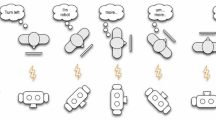Abstract
This paper presents an application of noninvasive sEMG-based interface to humanoid robot navigation control between remote places via wireless internet communication. sEMG signals to recognize three wrist movements are measured from the skin of a user’s arm. The wrist movements generate commands to the humanoid robot. The wrist movement directions are assigned to be intuitively comparable with the robot movement directions, therefore a user can control the robot in a natural way. By combining the state automation machine to the sEMG-based interface, possible robot movements are extended. To provide the environmental information of remote places, the images from the camera on the robot’s head are transmitted into the interface PC screen. We conducted experiments in which subjects control a humanoid robot to navigate from a starting position to a destination in a maze. The experimental results demonstrate the feasibility of the proposed interface method by comparing it with the keyboard control.
Similar content being viewed by others
References
Merletti, R. and Parker, P., “Electromyography: physiology, engineering, and non-invasive applications,” Wiley-IEEE Press, 2004.
Reaz, M. B. I., Hussain, M. S. and Mohd-Yasin, F., “Techniques of EMG Signal Analysis: Detection, Processing, Classification and Applications,” Biological Procedures Online, Vol. 8, No. 1, pp. 11–35, 2006.
Barreto, A. B., Scargle, S. D. and Adjouadi, M., “A practical EMG-based human-computer interface for users with motor disabilities,” Journal of Rehabilitation Research and Development, Vol. 37, No. 1, pp. 53–63, 2000.
Louis, N. and Gorce, P., “Upper limb muscle forces during a simple reach-to-grasp movement: a comparative study,” Med. Biol. Eng. Comp., Vol. 47, No. 11, pp. 1173–1179, 2009.
Artemiadis, P. K. and Kyriakopoulos, K. J., “EMG-Based Control of a Robot Arm Using Low-Dimensional Embeddings,” IEEE Trans. Robotics, Vol. 26, No. 2, pp. 393–398, 2010.
Fleischer, C. and Hommel, G., “A human-exoskeleton interface utilizing electromyography,” IEEE Trans. Robotics, Vol. 24, No. 4, pp. 872–882, 2008.
Jeong, H. and Choi, J. S., “An EMG-Controlled Graphic Interface Considering Wearability,” Proc. of the Human-Computer Interaction, pp. 958–961, 2003.
Chin, C., Barreto, A. N., Jing, Z. and Chao, L., “New classification algorithm for electromyography-based computer cursor control system,” Proc. of the IEEE Southeast Conf., pp. 428–432, 2005.
Choi, C., Micera, S., Carpaneto, J. and Kim, J., “Development and quantitative performance evaluation of a noninvasive EMG computer interface,” IEEE Trans. Biomed. Eng., Vol. 56, No. 1, pp. 188–191, 2009.
Choi, C. and Kim, J., “Development of a myoelectric joystick: a preliminary study,” Proc. of the IEEE RAS & EMBS Int. Conf. Biomed. Rob. & Biomech., pp. 173–178, 2010.
Lee, K. Y., Shin, K. Y., Kim, H. S. and Mun, J. H., “Estimating muscle fatigue of the biceps brachii using high to low band ratio in EMG during isotonic exercise,” Int. J. Precis. Eng. Manuf., Vol. 10, No. 3, pp. 147–153, 2009.
Clancy, E. A. and Hogan, N., “Probability density of the surface electromyogram and its relation to amplitude detectors,” IEEE Trans. Biomed. Eng., Vol. 46, No. 6, pp. 730–739, 1999.
Gouaillier, D., Hugel, V., Blazevic, P., Kilner, C., Monceaux, J., Lafourcade, P., Marnier, B., Serre, J. and Maisonnier, B., “Mechatronic design of NAO humanoid,” Proc. of the Int. Conf. Robotics and Automation, pp. 769–774, 2009.
Author information
Authors and Affiliations
Corresponding author
Rights and permissions
About this article
Cite this article
Chae, Y., Choi, C., Kim, J. et al. Noninvasive sEMG-based control for humanoid robot teleoperated navigation. Int. J. Precis. Eng. Manuf. 12, 1105–1110 (2011). https://doi.org/10.1007/s12541-011-0147-z
Received:
Accepted:
Published:
Issue Date:
DOI: https://doi.org/10.1007/s12541-011-0147-z




